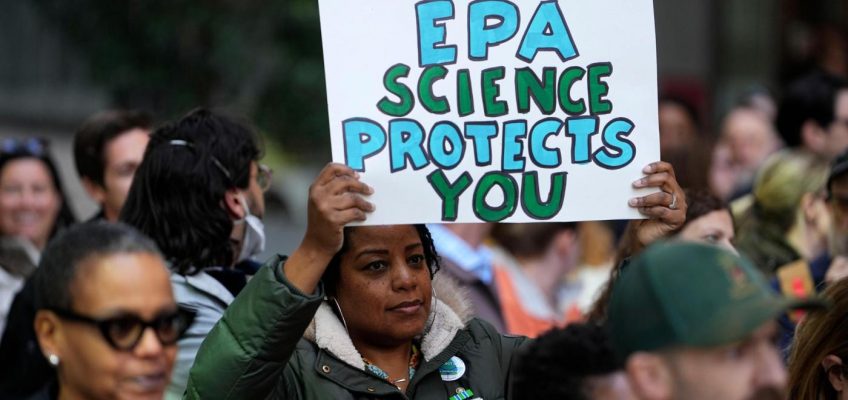By LISA MASCARO
WASHINGTON (AP) — Angry over the crush of court rulings against the Trump administration, Republicans in Congress are trying to slap back at the federal judiciary with proposals to limit the reach of its rulings, cut funding and even impeach judges, tightening the GOP’s grip on government.
Newly unsealed memo sheds light on Justice Department’s rush to drop NYC mayor’s corruption case
Trump signs order seeking to overhaul US elections, including requiring proof of citizenship
President Trump pardons former Hunter Biden business partner Devon Archer
US Vice President JD Vance to join his wife in Greenland on Friday
The US Postal Service has been struggling for years. Now Trump’s talking about privatizing it
House GOP leaders say all options are under consideration as they rush to rein in judges who are halting President Donald Trump’s actions at a rapid pace. In many cases, the courts are questioning whether the firings of federal workers, freezing of federal funds and shuttering of long-running federal offices are unlawful actions by the executive branch and Elon Musk’s Department of Government Efficiency.
In perhaps the most high-profile case, Judge James E. Boasberg ordered planeloads of deported immigrants to be turned around, raising the ire of Trump, who called for his impeachment, and billionaire Musk, who is funneling campaign cash to House Republicans backing impeachment efforts. The president calls the judges “lunatics.”
House Speaker Mike Johnson said Tuesday that “desperate times call for desperate measures” without mentioning impeachment.
“We do have authority over the federal courts, as you know,” the Republican speaker said. “We can eliminate an entire district court. We have power of funding over the courts, and all these other things.”
Not yet 100 days into the new administration, the unusual attack on the federal judiciary is the start of what is expected to be a protracted battle between the co-equal branches of government, unmatched in modern memory. As the White House tests the judiciary, trying to bend it to Trump’s demands, the Congress, controlled by the president’s own Republican Party, appears ready to back him up.
It all comes as the Supreme Court last summer granted the executive broad immunity from prosecution, setting the stage for the challenges to come. But Chief Justice John Roberts warned more recently that “impeachment is not an appropriate response to disagreement concerning a judicial decision.”
Democrats are warning against what they view as an assault on the judicial branch, which so far has been the only check against Trump and DOGE’s far-reaching federal actions. Threats against the federal judges, already on the rise, remain of high concern.
“It is outrageous to even think of defunding the courts,” said Senate Democratic Leader Chuck Schumer, reacting to the House speaker’s claims. “The courts are the bulwark against Trump, and the Republicans can’t stand it.”
House GOP leaders met Tuesday with Rep. Jim Jordan, the chairman of the House Judiciary Committee, which will hold a hearing on the issue next week. The House is also expected to vote on a bill from Rep. Darrell Issa, R-Calif., that would limit the geographic reach of certain federal rulings, to prevent temporary restraining orders from being enacted nationwide.
Jordan said he also spoke Saturday with Trump during college wrestling championships in Philadelphia.
“All options are on the table,” Jordan said late Monday. “We want to get the facts. Gather the facts.”
Since Trump took office, and with Musk, on a mission to dramatically reduce the size and scope of the federal government, the administration’s tech-inspired move-fast-and-break-things ethos has run up against the constraints of federal law.
An onslaught of court cases has been filed by employee groups, democracy organizations and advocacy groups trying to keep federal programs — from the U.S. Agency for International Development to the Education Department — from being dismantled.
Judges have issued various types of restraints on Trump’s actions. Trump’s first administration alone accounted for 66 percent of all the injunctions issued on presidential actions between 2001 and 2023, according to data from a Harvard Law Review piece circulated by Republicans.
The legislation from Issa had no support from Democrats when it was approved by the Judiciary Committee last month. A similar bill was introduced Monday by GOP Sen. Josh Hawley of Missouri.
Rep. Jamie Raskin, of Maryland, the top Democrat on the Judiciary panel, said Trump is being hit with injunctions because he is “engaged in terrible, irresponsible and lawless violations of people’s rights.“
“We are winning in court,” Raskin said in a video address. “We’ve got make sure we defend the integrity of the judiciary.”
When it comes to actually impeaching the judges, however, top Republicans have stopped short of backing what would be a severe action.
Impeachments are rare in Congress, particularly of judges, but several rank-and-file House Republicans have proposed legislation to launch impeachment proceedings against various federal judges who have ruled in ways unfavorable to the Trump administration.
Musk has rewarded House Republicans who signed onto impeachment legislation with political donations, according to a person familiar with information first reported by the New York Times. The person was granted anonymity to discuss the matter.
Republicans are particularly focused on Boasberg, the chief judge of the district court in Washington, D.C., who Jordan said is in a “somewhat unique in that, you know, his decision was crazy.”
The judge is weighing whether the Trump administration defied his order after the planes of migrants landed in El Salvador, turned over to that country’s notorious mega-prison system. The Trump administration had invoked the Alien Enemies Act, a war-time authority used during World War II against Japanese Americans, for the deportations the judge said lacked due process.
Any impeachment effort would also require backing from the Senate, where GOP leaders also panned the effort.
Senate Majority Leader John Thune, R-S.D., echoed the advice of Roberts in allowing normal legal procedures to play out.
“At the end of the day, there is a process, and there’s an appeals process, and you know, I suspect that’s ultimately how this will get handled,” Thune said.
Associated Press writers Leah Askarinam and Kevin Freking contributed to this report.




